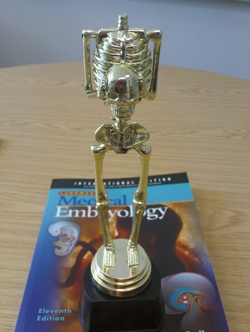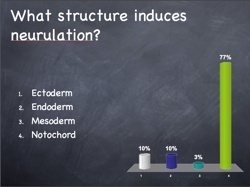 So that’s it, the embryology lecture series has finished. The final result of the quiz series was a draw, with the boys winning the final lecture quiz to level the series at 5:5.
So that’s it, the embryology lecture series has finished. The final result of the quiz series was a draw, with the boys winning the final lecture quiz to level the series at 5:5.
Given the really simple nature of the first couple of questions (and my awesome animations that I created to teach neurulation) I have a feeling that the boys may have been cheating. I’d expected more than 90% of the group to get the right answer, but only 77% were correct. I think some boys had signed up to the girls’ team and had put in the wrong answer deliberately. Should I state this publicly? Medical students cheating? The quiz had a large element of fun and competition to it, and at no point did I take it too seriously or expect anyone else to. I’m confident that if I’d asked the student group to play seriously and fairly they would have done so. The aims were to reinforce key parts of the lecture for the students and to give me immediate feedback about how much students had actually taken in (shockingly, apparently sleeping students often listen very well – there’s probably a medical education study to be done there). So a draw seems fair, or unfair. I don’t think it really matters.
Next year I’ll rethink the methods to try to limit the cheating, but it’ll still be done none too seriously. If we ever get those Windows Mobile PDAs connected to the network (or if the next student intake all get iPhones) maybe we’ll be able to add some new interactive stuff with the software version of Turning Point. I’ve got a bunch of new ideas floating in my brain too (not sure where though, my neuroscience knowledge is poor).
Unfortunately, with the new course much of the embryology lecture series will evaporate and I’ve still not finished fitting new lectures into the new timetable. The series will be shorter and will probably extend over 2 years. That may be too long to run a competitive quiz series like this. Maybe the decapitated skeleton trophy will stand forever in a draw(er), never to be won by either side.
 I really enjoyed giving the embryology lecture series this year. I was able to incorporate some of my own experiences from Annabel’s preterm birth to (hopefully) give a personal introduction to the subject and highlight the clinical importance of this area of biology. The quizzes were fun to do and generated buzz unusual for an embryology lecture theatre. I think we linked the embryology and the anatomy fairly well this year, and I believe that the student group has a good grasp of the important elements of development.
I really enjoyed giving the embryology lecture series this year. I was able to incorporate some of my own experiences from Annabel’s preterm birth to (hopefully) give a personal introduction to the subject and highlight the clinical importance of this area of biology. The quizzes were fun to do and generated buzz unusual for an embryology lecture theatre. I think we linked the embryology and the anatomy fairly well this year, and I believe that the student group has a good grasp of the important elements of development.
If you were a student this year, thank you for being involved in these lectures and for your helpful and very positive feedback. It really does affect what I do in the future.
Two more anatomy sessions and (apart from the exams) we’re done for year 1.